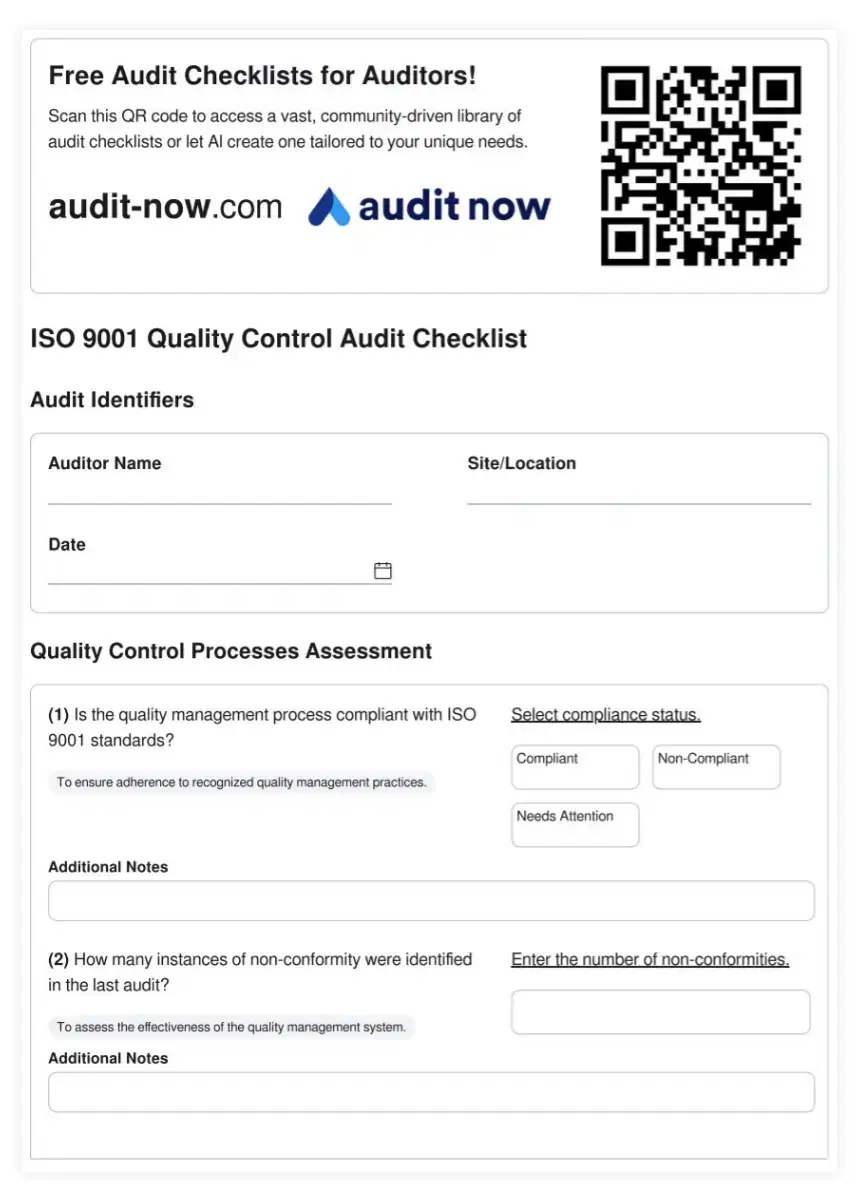Compliance Specialist Checklists

Featured Checklist

IATF 16949 Customer-Specific Requirements Audit Checklist
The IATF 16949 Customer-Specific Requirements Audit Checklist is a vital tool for automotive suppliers striving to meet the unique demands of their OEM customers. This checklist aligns with the International Automotive Task Force (IATF) 16949 standard while focusing on the specific requirements set by individual automotive manufacturers. By implementing this comprehensive audit tool, suppliers can ensure compliance with both industry standards and customer-specific expectations, reducing the risk of non-conformities and enhancing customer satisfaction. The checklist addresses key areas such as product quality, delivery performance, and communication processes, helping suppliers maintain strong relationships with OEMs and secure their position in the competitive automotive supply chain.
Compliance Specialist Operational Overview
Compliance specialists face a complex landscape of ever-changing regulations and standards. Keeping up with these changes while ensuring organizational adherence can be overwhelming. The challenge lies in interpreting new rules, implementing them effectively, and maintaining consistent compliance across all departments.
Operational excellence in compliance directly impacts business outcomes. Proper compliance management reduces legal risks, protects reputation, and builds trust with stakeholders. It also supports smooth operations by preventing costly violations and penalties. However, achieving this level of excellence requires meticulous attention to detail and robust quality management systems.
Quality management in compliance goes hand-in-hand with operational success. By implementing strong compliance processes, organizations can improve overall efficiency and reduce errors. This connection highlights the critical role of thorough auditing in maintaining compliance standards.
Core Audit Requirements & Checklist Importance
Effective compliance audits are built on several essential components. These include a comprehensive understanding of relevant regulations, a systematic approach to data collection, and thorough documentation of findings. Audits should also involve cross-functional collaboration to ensure all aspects of compliance are covered.
Systematic checklists play a crucial role in compliance auditing. They provide a structured framework for assessing compliance, ensuring consistency across audits, and reducing the risk of overlooking critical areas. Well-designed checklists also serve as valuable training tools for new compliance team members.
Compliance requirements vary widely depending on industry and jurisdiction. However, some common elements include data privacy protections, financial reporting standards, and workplace safety regulations. Meeting these requirements demands a proactive approach and regular self-assessment.
- Regulatory compliance: Ensure adherence to all applicable laws and regulations
- Policy implementation: Verify that internal policies align with compliance standards
- Risk assessment: Identify and evaluate potential compliance risks
- Training and awareness: Confirm that employees receive adequate compliance training
- Documentation and reporting: Maintain accurate records of compliance activities
Industry-Specific Compliance Challenges
Compliance specialists in different industries face unique challenges. For example, in the healthcare sector, HIPAA compliance requires strict protection of patient data. Financial services must navigate complex regulations like anti-money laundering laws and know-your-customer requirements. Manufacturing industries often grapple with environmental regulations and product safety standards.
Best practices for addressing these challenges include staying informed about industry-specific regulations, implementing robust compliance management systems, and fostering a culture of compliance throughout the organization. Regular training and clear communication of compliance expectations are also crucial.
Quality control measures in compliance often involve multi-layered approaches. This may include internal audits, third-party assessments, and continuous monitoring of key compliance indicators. Implementing technology solutions like compliance management software can also enhance oversight and reporting capabilities.
Optimizing Compliance Processes
Process optimization in compliance involves streamlining workflows without compromising thoroughness. This might include automating routine compliance tasks, standardizing reporting procedures, or implementing risk-based approaches to prioritize compliance efforts. For instance, a company might use automated data analysis tools to flag potential compliance issues for further investigation.
Effective risk management is central to compliance success. This involves identifying potential compliance risks, assessing their likelihood and impact, and developing mitigation strategies. A practical example might be creating a risk register that tracks and prioritizes compliance risks across different business units.
Key performance metrics for compliance often include the number of compliance violations, audit findings, and resolution times for identified issues. Other important metrics might track employee completion rates for compliance training or the timeliness of regulatory filings. Regular review of these metrics can help identify areas for improvement and demonstrate the value of compliance efforts to leadership.
Digital Transformation with Audit Now
Audit Now's AI-powered checklists revolutionize compliance management. Our intelligent system adapts to your specific industry requirements, suggesting relevant audit points and helping you stay ahead of regulatory changes. This dynamic approach ensures your checklists remain current and comprehensive, reducing the risk of oversight.
Our platform facilitates real-time collaboration among compliance team members, allowing for seamless information sharing and quick resolution of issues. With our extensive template library, you can jumpstart your compliance efforts using industry-tested frameworks. Experience the future of compliance management with Audit Now.
Ready to transform your compliance processes? Explore our template library at audit-now.com/templates/. For customized solutions, try our AI checklist generator at audit-now.com/generate-ai-checklist/.